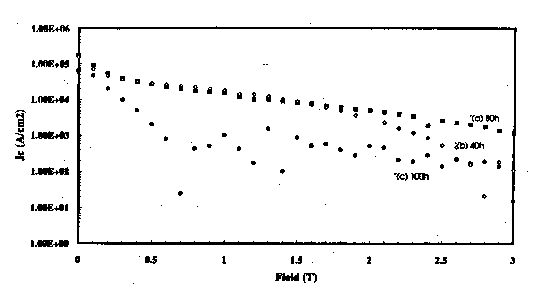
The magnetization of fiber samples annealed in oxygen at 500 C for 40 h, 80 h, and 100 h was measured under applied magnetic fields using a SQUID magnetometer. Samples were positioned with the c-axis of the 123 phase perpendicular to the applied magnetic field. Jc values were calculated using the Bean critical state model.[1] The calculated Jc values, plotted as a function of the applied magnetic field, are shown below. It can be seen that the Jc values for the samples annealed for 40 h and 80 h (curves (b) and (a), respectively) were similar for applied magnetic fields up to 2 Tesla. For applied magnetic fields above 2 Tesla, however, the Jc values for the 40 h sample decreased rapidly while those for the 80 h sample remained relatively high. The Jc of the fiber sample dropped significantly after additional annealing to 100 h, as can be seen from curve (c).

Comparison of the Jc values for the 40 h and 80 h samples shows that prolonged annealing increased the Jc of the fiber sample under magnetic fields applied parallel to the basal planes of the 123 phase. As described in the previous sections, the decomposition of the 123 phase and formation of second phase layers and 124 intergrowth is heavily dependent on annealing time. The results of the Jc measurements suggest a direct correlation between magnetic flux pinning and the decomposition microstructure.It is believed that 124 intergrowth which is formed during the decomposition reaction is responsible for enhanced flux pinning in the annealed samples. Comparison of the Jc values for the 80 h and 100 h samples shows that prolonged annealing will eventually decrease the critical current density. This result can be explained by the significant amount of the non-superconducting BaCuO2 second phase which forms during decomposition of the 123 phase. An optimum annealing schedule must therefore be found to balance the formation of 124 intergrowth and second phase layers.
--------
[1] C.P. Bean: Rev. Mod. Phys., 36, 31(1964).
©CPRL, 1995